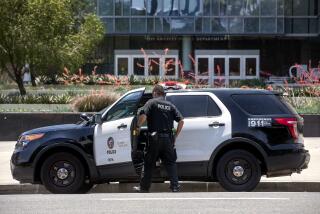Calls Mishandled in Test of 911 by Deafness Council : Emergencies: Group conducts checks after a police operator mistakenly hangs up on a caller.
Test calls on the special phones used by deaf people to report emergencies showed that 911 operators do not always know how to use the necessary equipment, an organization for the deaf said Wednesday.
Three test calls were made because of an increase in fears in the deaf community after a police operator mistakenly hung up on a deaf Northridge man trying to report that his 80-year-old wife was dying, a spokeswoman for the Greater Los Angeles Council on Deafness said Wednesday. Only one was successful, the spokeswoman said.
The tests show that emergency operators sometimes hang up on deaf people because the operators don’t recognize a beeping signal that sounds in their headsets when calls come in from the phone-teletype machines used by the deaf, said Marge Klugman, a referral specialist with the deafness council.
The tone should alert the operator to transfer the call to a TDD--Telecommunications Device for the Deaf--a teletype-like printer and keyboard which can be used to communicate with the deaf in writing.
Klugman said that when she called 911 last week, an operator hung up on her. Klugman said a second call did not go through. When she called back a third time, she confronted another operator. According to a printout of the conversation from Klugman’s TDD, the operator explained that the first person who answered “didn’t recognize the new tone we are getting when it rings.”
Pacific Bell officials said Wednesday that all TDD machines emit the same beep and so far as they knew should not sound different to police operators. All TDDs are compatible with all 911 systems, they said.
“Three years ago I called 911 as a test from my office and the same thing happened,” Klugman, who is deaf, said through an interpreter. “Three times they hung up on me.”
A Los Angeles Police Department spokesman declined to comment on the incident, saying he wanted to check the department’s records of the call.
In the case that caused the concerns, Irving Linden, 72, had started a typed conversation with an operator on March 8 in an attempt to report that his wife, Sylvia, was having trouble breathing. The operator hung up after not receiving an immediate reply from him on the TDD.
Unaware that the call had been disconnected, he continued to type messages, including his request for paramedics and his address. He waited 10 minutes before calling the Fire Department directly, but his wife had died by the time paramedics arrived.
Capt. Forrest Lewallen, commander of police emergency communications, said paramedics reported that the woman would not have survived even if help had arrived sooner.
Lewallen also said that the disconnection was an isolated incident and not representative of an inherent problem with the system.
However, as a result of the incident, Los Angeles 911 operators have been ordered to automatically call back all TDD calls that are disconnected, and if communication is not re-established, to send a patrol car to the address where the call originated.
Members of Los Angeles’ deaf community say they have long been worried about using their TDDs to call 911.
“It’s not very often that a deaf person will call and the people at 911 maybe will forget there’s such a thing as a TDD,” said Herb Larson, director of the National Center on Deafness at Cal State Northridge.
Police confirmed that 911 calls from TDD machines are sporadic.
Problems with emergency calls from TDDs first came to light in April, 1986. Jay Shufeldt, 74, returned to his San Diego home and found that his wife, Mary Bell, had collapsed. He said he tried repeatedly to call 911 on his TDD and was unable to get through. He eventually reached his daughter, who can hear and who called 911 from her home. But by the time paramedics arrived at the Shufeldt home, Mary Bell Shufeldt had died.
More to Read
Sign up for Essential California
The most important California stories and recommendations in your inbox every morning.
You may occasionally receive promotional content from the Los Angeles Times.











